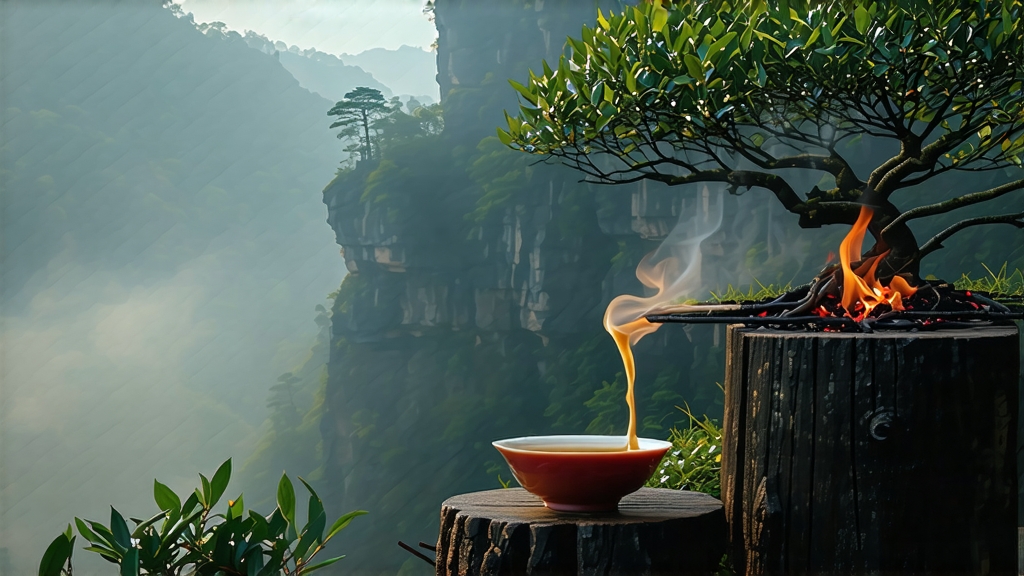
If green tea is the dew-fresh poetry of spring and pu-erh the earthy chronicle of time, then Da Hong Pao—literally “Big Red Robe”—is the dramatic aria sung between basalt and fire. Hailing from the vertiginous Wuyi Mountains in northern Fujian, this rock oolong (yancha) carries the terroir of a UNESCO dual heritage site where 400-million-year-old cliffs press narrow terraces of mineral soil against the Min River mist. Every leaf is a palimpsest of Song-dynasty monks, Ming-era imperial couriers, Qing charcoal masters, and modern nanometer roasting drums. To drink Da Hong Pao is to taste tectonic memory, incense smoke, and the ambition of Chinese artisans who learned to coax orchid fragrance from stone.
- Myth, History, and Market Reality
The origin myth is irresistible: a Ming scholar on his way to the capital falls ill in the Wuyi valley, is revived by a brew made by local monks, and later returns in crimson robes to drape the bushes in gratitude. The emperor, hearing of the miracle, declares the six mother trees protected and grants them the imperial red robe. Those original bushes—clinging to a cleft called Jiulongke—still live, now 350 years old and barricaded behind a camera-monitored fence. Since 2006 their plucking has been outlawed; the last 20 g of mother-tree tea auctioned for ¥280,000 (US$40,000) per gram.
Yet “Da Hong Pao” today is less a single tree than a protected geographical indication (PGI) that allows three legally distinct products:
a) Pure pedigree tea grafted from the mother trees (xiaozhong) grown inside the 60 km² core scenic zone.
b) Blended yancha that marries pedigree cuttings with other Wuyi cultivars such as Rougui, Shui Xian, or Bei Dou.
c) Commercial “flavor-profile” DHP made from high-yield Shui Xian base tea scented with oak-wood smoke and caramel color to mimic the roasted sweetness consumers expect.
Knowing which cup you hold is step one to appreciating what follows.
-
Cultivars That Wear the Robe
Although the name is singular, the genetic wardrobe is plural. The original “Qi Dan” clone produces a slender, purplish leaf with low yield but piercing floral top notes. “Bei Dou No. 1,” bred in 1980 from cuttings taken in 1964, offers a rounder, honeyed body. “Que She (Sparrow Tongue)” delivers a sharper mineral bite, while “Tie Luo Han (Iron Arhat)” brings a deeper, almost medicinal bitterness beloved by old-school Chaozhou merchants. Each cultivar is still processed as yancha, yet the differences in leaf chemistry mean roasting schedules and fire temperatures must be recalibrated bush by bush. -
Crafting the Cliff Essence: A 21-Step Choreography
Plucking: only the middle 3–4 leaves are taken once the spring sun warms the cliff terraces to 18 °C, usually between late April and early May. The older leaf standard gives the tea stamina against the brutal roast to come.
Withering: leaves are spread on bamboo sieves set on racks inside a “qing” hut heated indirectly by charcoal embers buried in ash. The goal is 65 % moisture loss over 4–6 h while the leaf edges turn matte.
Shaking: every 30 min the tea is tossed in rattan drums to bruise cell walls, initiating oxidation. Masters listen for a rustle that sounds like distant rain on silk—too loud means tearing, too soft means under-oxidized.
Fixation: a 280 °C wok arrest oxidation at 30–35 %, preserving the signature greenish center and bronze rim.
Rolling: the hot leaves are wrapped in cotton cloth and rolled on rattan mats until they resemble dark dragon whiskers.
Roasting round 1 (maohuo): 100 °C for 2 h over local hardwood charcoal, then 3 days of rest.
Roasting round 2 (zuhuo): 80 °C for 4 h, followed by a week of “back-basket” breathing in hemp sacks.
Roasting round 3 (laohuo): 60 °C for 6–10 h, repeated up to three times over